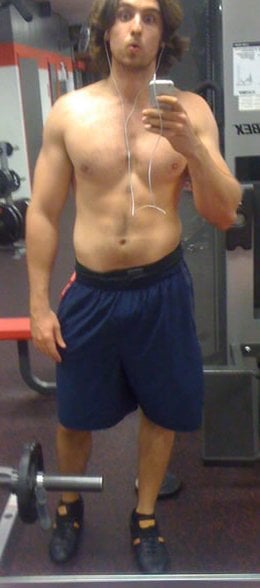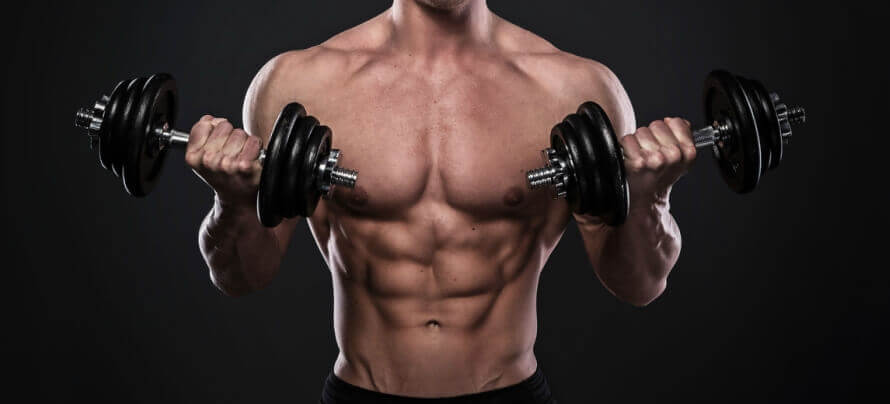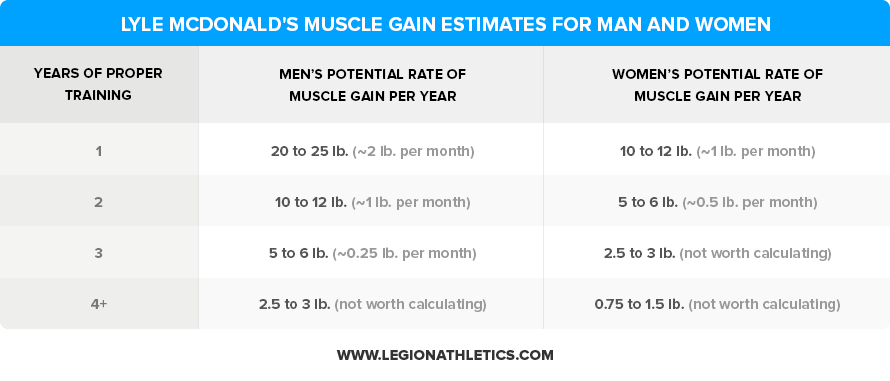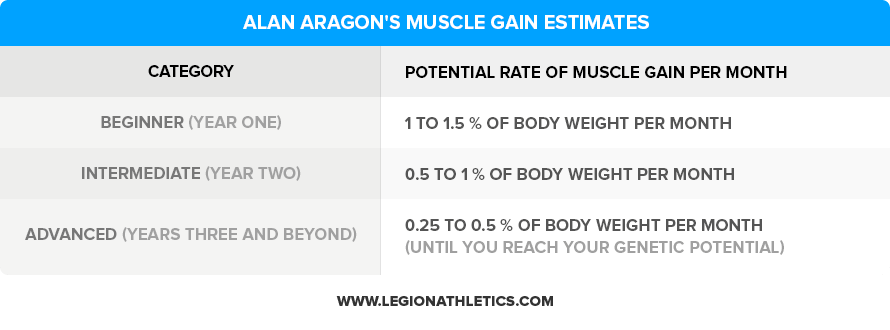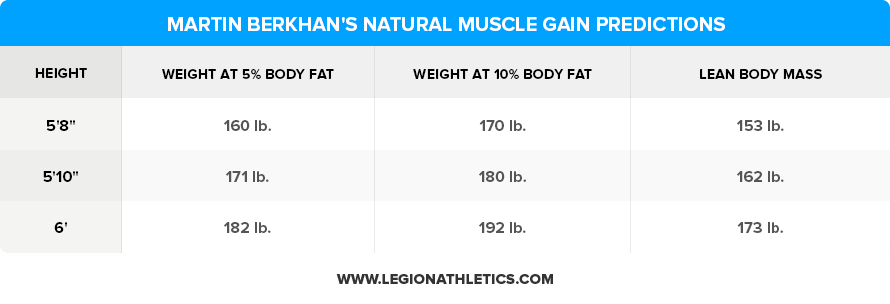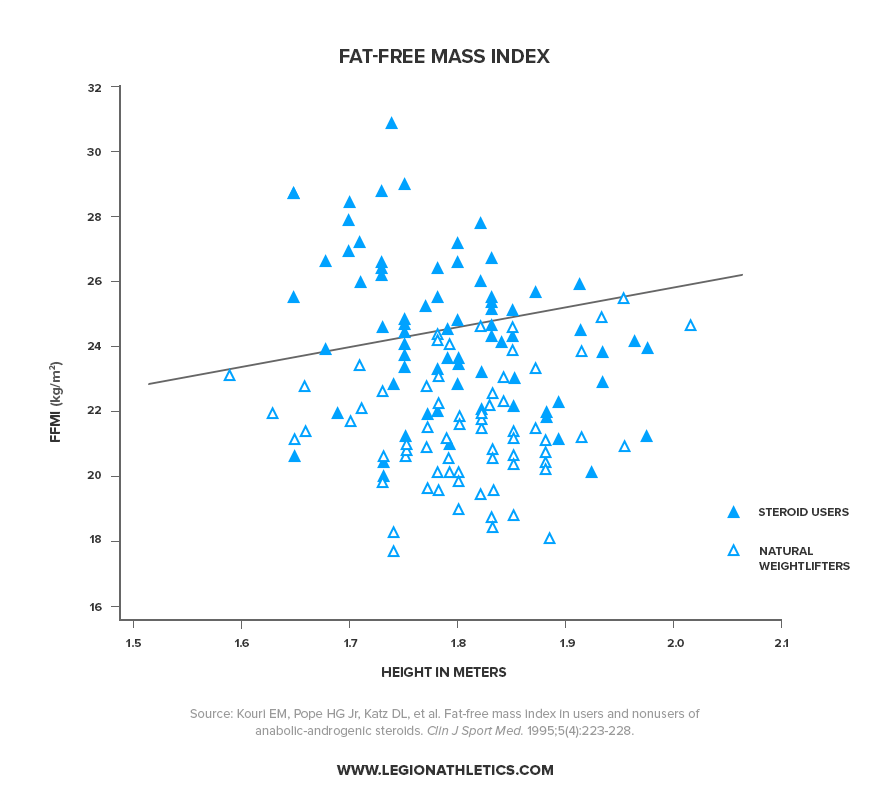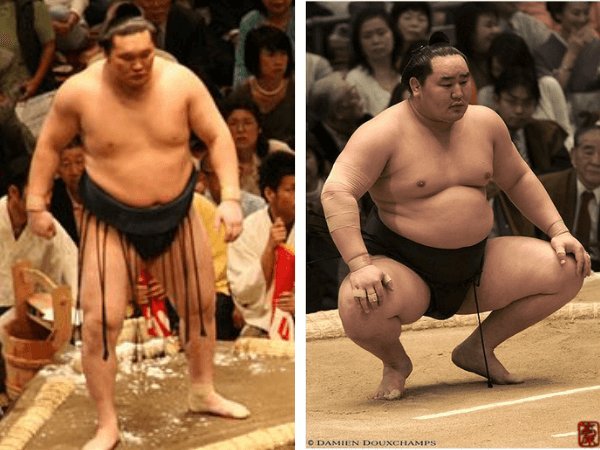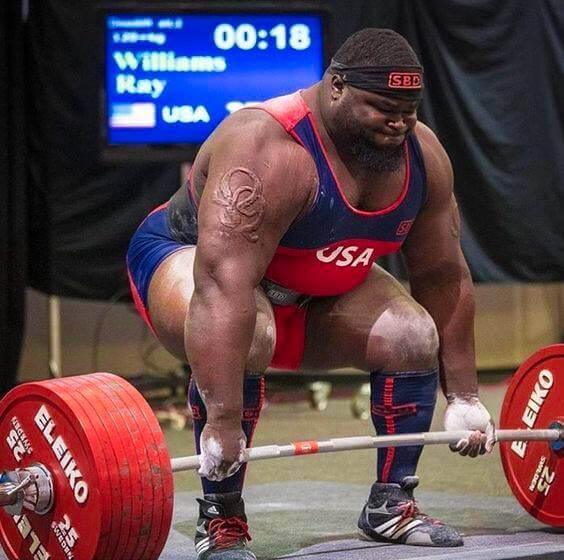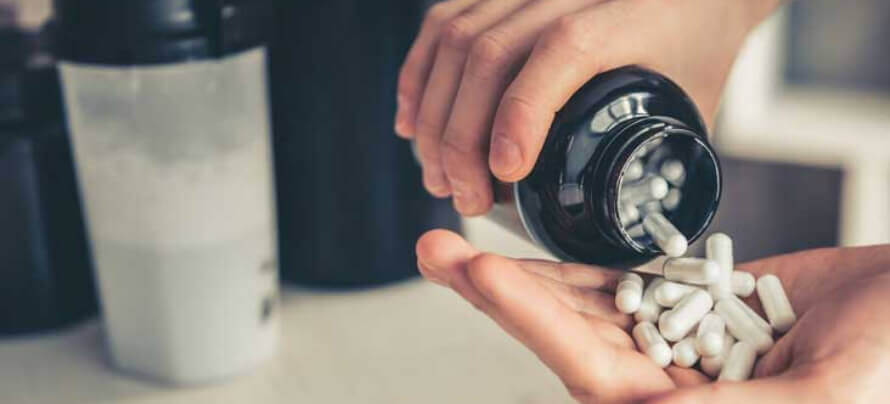This article is from the new second edition of my bestselling fitness book for experienced weightlifters, Beyond Bigger Leaner Stronger, which is now live everywhere you can buy books online.
Also, to celebrate the book’s release, I’m giving away over $6,000 of glorious goodies, including a 30-minute Zoom call with yours unruly, Vitamix blender, Hypervolt Bluetooth massage gun, and more. Click here to learn how to win.
Just want to know how much muscle you can gain naturally? This calculator will tell you:
Want to learn the science behind this calculator and how to reach your genetic potential for muscle gain as fast as possible? Keep reading.
Key Takeaways
- Most men can naturally gain 40 to 50 pounds of muscle in their lifetimes, and most women can naturally gain 20 to 25 pounds.
- Research shows that you can use the circumference of your wrists and ankles to predict how much muscle you can gain naturally.
- It takes at least 4 to 5 years of proper dieting and training to approach your genetic potential for whole-body muscularity—keep reading to learn how to get there as fast as possible!
Some people say that with enough hard work, patience, and food, you can get as big and strong as you want.
That there are no hard limits to your potential for whole-body muscle gain.
Others say all it takes to more or less max out your size and strength is a few years of proper training, unless you have elite genetics and a penchant for pain.
Both sides often have persuasive physiological arguments, which can be difficult to evaluate as a layman.
The meteoric rise of steroid use has complicated matters further, because while some guys (and gals) are so big and strong that steroids are obviously involved, many drug users fly under the radar and represent unrealistic expectations.
To avoid the issue of secret anabolic use, often people point to the exceptional muscularity of bodybuilders before the advent of synthetic testosterone and other steroids in the late 1930s, like the great Eugen Sandow:
This, they say, is the purest, cleanest example of what’s possible without drugs.
If only it were that simple.
The home truth is this:
We can only gain so much muscle naturally, and no amount of training, eating, or supplementing will raise that ceiling.
Furthermore, it’s impossible to calculate or predict that ceiling precisely, but there are several research-backed methods for estimating how jacked we can get.
There’s good news, too: chances are you haven’t reached your peak muscularity yet.
In fact, you’re probably nowhere close.
My progress is a good example of this. Here’s what I looked like after 1.5 years of following traditional bodybuilding training and diet advice:
I’d gained about 20 pounds (~175 pounds here), which isn’t very impressive considering most of it was gained in the first ten months—the “newbie gains phase.”
Here’s another shot of me taken several years later:
At this point I’d been training for about seven years, weighed around 195 pounds, and was about 16{740fcf70e3ac1f1193a1b542e1c9e953922ad085105f0bf8299e70261e238f62} body fat. I’d gained a fair amount of size along the way, but was stuck in a rut—I hadn’t made any real progress in size or strength for years and thought maybe this was it.
Soon after taking that last picture, however, I dramatically changed the way I was eating and training, and here’s me just a few years later:
That’s me at about 185 pounds and 7{740fcf70e3ac1f1193a1b542e1c9e953922ad085105f0bf8299e70261e238f62} body fat, so I had gained another 10 pounds of muscle, despite thinking I was an “intermediate” or even “advanced” weightlifter (I wasn’t).
And just in case it needs saying, I’ve never used steroids, prohormones, SARMs, clenbuterol, or any other drug (besides caffeine, synephrine, and ephedrine) to get here.
The moral of the story is you may think your DNA dealt you a busted flush, but it probably didn’t.
Although you can only gain so much muscle, the amount is likely a lot more than what you see in the mirror and certainly more than enough to look and feel great about your body.
And in this article you’ll get clear answers to all your most pressing questions about your muscle building potential, including . . .
- How much muscle can you gain naturally?
- Why can some people gain more muscle than others?
- What’s the most surefire way to reach your genetic potential for muscle growth as fast as possible?
- And more
Let’s get started.
Would you rather listen to this article? Click the play button below!
Want to listen to more stuff like this? Check out my podcast!
What Determines How Much Muscle You Can Build Naturally?
There are many calculators and formulas floating around online that claim to show how much muscle you can add to your frame.
While some can give you a ballpark estimate, don’t put too much stock into their estimations, because there’s no perfect way to predict how big you can get. There are too many physiological variables. This is why even genetic testing provides little more than an informed guesstimate.
That said, science has revealed two physical traits that are highly correlated with the genetic potential for muscle gain:
- Bone structure
- Muscle structure
Let’s review each.
Bone Structure and Muscle Gain
It’s true—some big people are just “big boned.”
Research shows that those with larger, denser bones tend to have more muscle than people with smaller frames. Furthermore, they also tend to have higher testosterone levels and respond better to training.
This relationship is so strong that some scientists believe that how much bone you have is the limiting factor in natural muscle building.
One researcher in particular, Francis Holway, has even gone as far as calculating what he believes is the exact ratio of how much muscle you can gain according to how much bone you have.
Here’s how David Epstein explains it in his 2014 bestselling book The Sports Gene:
In measurements of thousands of elite athletes from soccer to weight lifting, judo, rugby, and more, Holway has found that each kilogram (2.2 pounds) of bone supports a maximum of five kilograms (11 pounds) of muscle.
In other words, most people can gain about five pounds of muscle for every pound of bone in their bodies.
Epstein likens the human skeleton to a bookcase, and the muscle to books, writing, “One bookcase that is four inches wider than another will weigh only slightly more. But fill both cases with books and suddenly the little bit of extra width on the broader bookcase translates to a considerable amount of weight.”
Also worth noting is the ratio seems to be slightly lower—about 4.1 pounds of muscle to 1 pound of bone—in women, which may help explain why women’s potential for muscularity is less than men’s.
You might now be wondering how to accurately measure your total bone mass and thereby muscular potential.
Unfortunately, it involves a trained anthropometrist (body measurer) taking twenty-two different measurements across your body, which is expensive and inconvenient.
Some people say you can use a full-body x-ray called a DXA scan instead, but that’s not a workable solution either. DXA determines the mineral content of your bone, not the total weight, which includes marrow, blood, and other components.
So, while the muscle-to-bone ratio is probably the best method we have for determining the maximum amount of muscle we can build naturally, it’s unfeasible.
Instead, however, we can use two scientifically validated proxies for our overall bone mass: the circumferences of our wrists and ankles.
These measurements work because height being equal, people who have wider wrists and ankles tend to be more muscular, gain muscle faster through training, and have a higher potential for muscle growth.
We can thank a researcher named Casey Butt, Ph.D., for figuring this out.
He parsed thousands of data points from surveys, clinical studies, and case studies, and found the single best indicator of bone mass and thus muscle-building potential was the thickness of the wrists and ankles.
Why these two points of the body?
It’s likely that you could also find a similar relationship using other bones like the femur (thigh bone), humerus (upper arm bone), and clavicle (collar bone), but they’re too draped in flesh to allow for easy measurement. That isn’t the case with the wrists and ankles, though.
Butt, an avid lifter himself, also used his research to create a formula that allows you to easily predict your muscle-building potential, which we’ll talk more about in a minute.
Summary: Your maximum potential for natural muscle gain is limited by the size of your skeleton. Thus, by estimating the size of your bones, you can estimate your genetic potential for muscle gain (keep reading to learn how!).
Muscle Structure and Muscle Gain
Every muscle has two main parts:
- The “belly,” which is the part that contracts and that you want to grow.
- The tendon, which connects the belly to your skeleton.
The main way muscle bellies and tendons vary in people is length. Muscles can’t grow longer, only wider, so the longer your muscle bellies and the shorter your tendons are, the more muscle mass you’ll be able to gain.
Similarly, the shorter your bellies and the longer your tendons are, the lower your potential for muscularity.
Here’s a good example of someone with very short muscle bellies and long tendons:
While he has good muscle definition, he’ll have a hell of a time getting bodybuilding-big arms.
Just to compare, here’s a shot of my arm, which has a longer muscle belly:
If you want to know how your biceps stack up, bend your arm to 90 degrees, flex your biceps, and see how many fingers you can comfortably fit between your biceps and forearm.
If you can fit three fingers, your muscle bellies are below average length. If you can fit two, you’re about average. If you can fit one, you’re one of the lucky few with longer than average muscle bellies.
If you’re on #TeamSmallBelly, don’t worry, you aren’t SOL. Take heart because . . .
- Small muscle bellies in one muscle group (your biceps) doesn’t mean the same will hold true in other muscle groups.
- Although your potential for raw size might be more limited than some, you can always develop great muscle definition (like this guy).
- There are other factors that are better predictors of how muscular you can get (which you’ll learn more about).
And let’s face it: there isn’t a natural bodybuilder in the world with 10 out of 10 size and definition in every muscle group, so let’s be thankful for our strengths (yippee, chest and biceps for me) and accepting of our weak points (screw you, calves).
Summary: Your muscle structure partially determines the size and shape of particular muscles, and this is something you can’t change. Even if your muscle structure is “suboptimal” by bodybuilding standards, though, you can still build an impressive physique.
What About Testosterone and Muscle Gain?
No discussion of the natural limitations of muscle gain would be complete without talking about the big T.
It’s the primary hormonal driver of muscle growth, after all.
In fact, its muscle-building effects are so strong that research shows artificially increasing your testosterone levels can put muscle on your frame with no exercise whatsoever.
In a study conducted by scientists at the Charles R. Drew University of Medicine and Science, researchers split forty-three resistance-trained men ranging from nineteen to forty years of age into four groups:
- Group one consumed a placebo and didn’t lift weights.
- Group two was injected with 600 milligrams of testosterone and didn’t lift weights.
- Group three consumed a placebo and lifted weights.
- Group four was injected with 600 milligrams of testosterone and lifted weights.
Everyone followed this protocol for ten weeks, and before and after the study, the researchers measured the participants’ weight, strength, and body composition.
And the results illustrate why steroids are so popular.
As expected, the guys who didn’t lift weights or take steroids didn’t gain any muscle to speak of and added a measly 7 pounds to their squat and nothing to their bench press.
The natty lifters in group three fared significantly better and gained about 4.5 pounds of muscle and added about 77 pounds to their squat and bench press, which is fantastic for ten weeks of training.
They could’ve skipped all the workouts, though, and just injected testosterone instead.
On average, the men in group two who took steroids and sat on their butts for ten weeks gained 7 pounds of muscle and added 70 pounds to their squat and bench press. It gets better, too.
The people in group four who took steroids and lifted weights gained a mind-boggling 13.5 pounds of muscle. In ten freaking weeks.
Yes, that’s 1.3 pounds of muscle per week and about half the amount a guy with above-average genetics could expect in his first year of weightlifting.
The steroided lifters also increased their squat and bench press total by a whopping 132 pounds and gained eight times more size in their triceps and twice as much size in their quads as the natty lifters.
And let’s not forget this study was on the effects of testosterone, which are only further magnified by other popular anabolic steroids including trenbolone, winstrol, dianabol, nandrolone, and others.
So now you know what to think when someone trots out the “why would he/she/I lie about taking steroids?” red herring.
People lie about taking steroids, because for just a couple of hundred dollars per month, you can use them to get jacked and shredded shockingly fast.
Based on this extreme example, it would seem a reasonable assumption that our testosterone levels would influence how much muscle we can gain.
This is where things get interesting.
That assumption is true if we’re talking about raising testosterone levels through steroid use, like in the study you just learned about. This raises the ceiling for muscle gain.
But here’s something that most people don’t know: fluctuation of testosterone levels within the physiological normal range doesn’t much help or hurt muscle growth.
In other words, if you increase your testosterone levels but they remain well within the range of normal—around 300 to 1,000 ng/dl—you’re unlikely to notice any muscle-building benefits.
For reference, the average testosterone level among the lifters taking steroids in the study we just discussed was 3,244 ng/dl, or over three times the upper limit of natural testosterone production. And that was a baby dose by bodybuilding standards.
So, while natural testosterone levels influence muscle gain to a certain degree, it’s just not as important as most people think. On the whole, your bone and muscle structures are much better predictors of how big you can get naturally.
That assumption is certainly true if we’re talking about dramatically raising testosterone levels through steroid use, like in the study you just learned about. This most definitely raises the ceiling for muscle gain.
Summary: Fluctuation of testosterone levels within the physiological normal range doesn’t much help or hurt muscle growth. You have to raise testosterone levels significantly above natural levels (using steroids) to boost muscle growth.
How Much Muscle Can You Build Naturally?
By this point, you’ve probably had enough appetizers and are ready for your entrée. So let’s serve it up.
How can you determine how much muscle you can gain?
Most formulas for this are solely based on height. The theory is the taller you are, the more “room” you have to add muscle to your body.
There’s truth here, but it’s too simplistic to produce accurate estimates for people of all sizes and types.
For example, what if you’re below-average in height but above-average in bone size? You’d be able to gain more muscle than a height-based formula would predict.
That’s why I prefer Casey Butt’s formula.
That said, the downside to Butt’s formula is it’s only reliably accurate for men because all the data it was derived from was collected from men. Thus, we can’t be sure its calculations are equally applicable to women.
Women aren’t out of luck, however. There are other ways for them to estimate how much muscle they can gain, which we’ll get into in a minute.
Casey Butt’s Model for Predicting Muscular Potential
Butt’s equations are widely considered the most accurate way to estimate your genetic potential for muscle growth as well as the maximum potential size of each major muscle group.
Here’s what they look like . . .
Maximum Lean Body Mass = H1.5 (√W ÷ 22.667 + √A ÷ 17.0104)({740fcf70e3ac1f1193a1b542e1c9e953922ad085105f0bf8299e70261e238f62}bf ÷ 224 + 1)
Maximum Chest Circumference = 1.6817W + 1.3759A + 0.3314H
Maximum Biceps Circumference = 1.2033W + 0.1236H
Maximum Forearm Circumference = 0.9626W + 0.0989H
Maximum Neck Circumference = 1.1424W + 0.1236H
Maximum Thigh Circumference = 1.3868A + 0.1805H
Maximum Calf Circumference = 0.9298A + 0.1210H
H = Height in inches
A = Ankle circumference at the smallest point
W = Wrist circumference measured on the hand side of the styloid process
{740fcf70e3ac1f1193a1b542e1c9e953922ad085105f0bf8299e70261e238f62}bf = Body fat percentage at which you want to predict your maximum lean body mass
Chances are that looks like gobbledygook to you, which is why I made a nifty calculator that does all the math for you. Here it is again:
How to Use the Casey Butt Calculator
1. Select what unit you’d like to use (imperial or metric).
2. Enter your height in inches or centimeters.
3. Enter your wrist circumference in inches or centimeters.
To measure, find the bony lump on the outside of your wrist (the styloid process), open your hand, and wrap a tape measure around the space between that lump and your hand.
4. Enter your ankle circumference in inches or centimeters.
To measure, wrap a tape measure around your lower leg between your ankle bone and your calf muscle. Move the tape measure around to find the narrowest point.
5. Enter your ideal body fat percentage if you were to be at 100{740fcf70e3ac1f1193a1b542e1c9e953922ad085105f0bf8299e70261e238f62} of your muscle-building potential.
I recommend 10{740fcf70e3ac1f1193a1b542e1c9e953922ad085105f0bf8299e70261e238f62} because lower than that simply isn’t sustainable for most guys.
You may have noticed that this calculator gives you two sets of numbers: your maximum potential for muscle gain, and your realistic potential for muscle gain.
Why the two different results?
Although Butt’s formulas are based on records from “natural bodybuilders,” many may have been using drugs. It’s easy to cheat drug tests in most sports, bodybuilding especially, and steroids were legal and generally not tested for until about the 1980s.
Thus, it’s safe to assume that Butt’s numbers may be slightly inflated because of undisclosed steroid use.
Additionally, much of the data came from top-level bodybuilders who comprise the genetic elite for muscle gain.
Therefore, it’s smart to look at your maximum numbers from the calculator as an absolute ceiling of what you could achieve if you did everything right with your training and nutrition for years, rather than middle-of-the-road expectations.
This is why it’s reasonable to subtract 5{740fcf70e3ac1f1193a1b542e1c9e953922ad085105f0bf8299e70261e238f62} from your maximum drug-free results for a more conservative estimate of how big we can get, without more or less devoting our lives to lifting weights. This gives you your realistic potential for drug-free muscle gain.
For example, when I plug in my numbers, the calculator pegs my ceiling at 210 pounds at 10{740fcf70e3ac1f1193a1b542e1c9e953922ad085105f0bf8299e70261e238f62} body fat.
I’m sitting at 192 pounds right now at 9{740fcf70e3ac1f1193a1b542e1c9e953922ad085105f0bf8299e70261e238f62} body fat, and based on my nearly twenty years in the gym, I can say with some certainty that I have a snail’s chance in saltwater of reaching 210 pounds and lean.
If I subtract 5{740fcf70e3ac1f1193a1b542e1c9e953922ad085105f0bf8299e70261e238f62} from 210, however, I get 199, which is my realistic drug-free body weight at 10{740fcf70e3ac1f1193a1b542e1c9e953922ad085105f0bf8299e70261e238f62} body fat. This would require just a few pounds of muscle gain, and means I’ve gained more or less all the muscle available to me, regardless of what I do in the kitchen or gym going forward.
Also, in case you missed it above, this calculator uses a formula derived from data collected solely from men, so it won’t work for any women in your life who might be curious.
There may be a similar correlation between bone and muscle mass in women just as in men, and if so, then Butt’s formula would predict potential muscle gain just as well in women as in men. We just don’t know yet, though.
The good news is there are several other evidence-based ways to estimate how much muscle we can gain that also work for women.
I want to share three methods in particular, which were developed by Lyle McDonald, Alan Aragon, and Martin Berkhan.
Altogether, Lyle, Alan, and Martin have worked with hundreds of elite bodybuilders and athletes and are, I think, some of the smartest guys in the evidence-based fitness space.
Let’s look at what they have to say about muscle-building potential.
Lyle McDonald’s Answer
Lyle McDonald is a health and fitness researcher and writer, and his formula is based on his extensive reading of the research and one-on-one experience helping thousands of people build muscle and lose fat.
According to Lyle, most people will gain muscle more or less on this timescale:
As you can see, Lyle says that guys can gain up to 40 to 50 lbs of muscle in their first 4 to 5 years of proper diet and training, and, unfortunately, that muscle gain is fairly negligible from there on out.
Furthermore, Lyle believes both age and starting condition reduce the potential for muscle gain. Older guys and gals will generally gain less than younger, and underweight people can gain a bit more than his data would suggest.
Also notice that I said 4 to 5 years of proper training (and diet), not just training, or worse, “exercising.”
Lyle has concluded that someone who has been training improperly for several years has the potential to make “year one” gains when he or she starts training properly. I can attest to that personally, and I’ll get to what proper training looks like in a minute.
If you want to learn more about how Lyle arrived at these numbers, and his thoughts on how much muscle men and women can gain naturally, check out this interview I did with him:
Listen: Lyle McDonald on How Much Muscle You Can (Really) Gain Naturally
And just to make things easier and more fun, here’s a calculator that’ll show you how much muscle you can expect to gain over the next year, based on Lyle’s research:
Alan Aragon’s Answer
Alan Aragon is a published researcher and fitness consultant who’s been designing programs for improving body composition and athleticism for over 20 years.
Based on what he’s seen working with everyone from everyday gymgoers to Olympic athletes, most men can gain muscle at about this rate:
Women, he says, should aim for about half this rate of progress for several reasons, including less bone mass, a smaller and weaker starting point, and others.
I should also mention that those numbers assume you’re doing the most important things with your eating and training mostly right. If a guy has been in the gym for many years but only gained, let’s say, 15 pounds of muscle, he’s essentially a beginner ready to start his second year.
So, according to this model, a 150-pound male beginner can gain about 1.5 to 2.25 pounds of muscle per month, or 18 to 27 pounds in year one.
Let’s say he does well and gains 20 pounds of muscle in his first year and is now an “intermediate lifter” who can expect to gain 0.85 to 1.7 pounds of muscle per month, or 10 to 20 pounds in his second year in the gym.
Let’s say he now really dials in his diet and training and gains another 15 pounds of muscle in year two, putting him at 185 pounds (assuming the same body fat levels as when he began) as he enters his “advanced” phase.
Thus, his year-three potential gains are about 5 to 10 pounds of muscle, and from there on out, his progress diminishes to the vanishing point.
This example mirrors my journey in a way. Although it took much longer than it should’ve, I started weightlifting at about 155 pounds and 13 percent body fat and am now 192 pounds and 9 percent.
Martin Berkhan’s Answer
Martin Berkhan is a writer and fitness consultant, and his specialty is helping people get ridiculously lean.
As a result, he’s seen and reflected on many examples of what a natural lifter can achieve in terms of body composition.
Based on his observations and calculations, Martin developed a simple formula:
Height in centimeters minus 100 = Upper weight limit in kilograms in contest shape (4 to 5 percent body fat)
Here’s how this works for a few heights and poundages:
To calculate Martin’s predictions for other heights, multiply them in inches by 2.54 to convert into centimeters, and subtract 100 for your maximum weight in kilograms at 5{740fcf70e3ac1f1193a1b542e1c9e953922ad085105f0bf8299e70261e238f62} body fat (stage-ready shredded).
Read: How to Calculate Your Body Fat Percentage Easily & Accurately (With a Calculator)
Finally, multiply this number by 2.2 to convert it back into pounds.
For example, I’m 6’1, which works out to 73 inches.
73 x 2.54 = 185
185 – 100 = 85
85 / 2.2 = 187
According to Martin’s formula, the most I could ever hope to weigh at 5{740fcf70e3ac1f1193a1b542e1c9e953922ad085105f0bf8299e70261e238f62} body fat is 187 pounds, which is just above my weight when I was at my leanest (183).
Again, this squares with Butt’s, Aragon’s, and McDonald’s formulas, which all say I’m just a few pounds shy of my maximum potential for natural muscle gain.
Summary: No calculator can perfectly predict how much muscle you can build naturally, but on average, men can expect to gain around 40 to 50 pounds of muscle in their lifetimes, and women can expect to gain around 20 to 25 pounds.
Some Much-Needed Perspective on Expectations
If your numbers have let some of the air out of your balloon, I understand.
You probably follow quite a few bodybuilders, fitness models, and “influencers” who put your potential for muscle gain to shame.
And that’s okay.
In fact, it’s good you’re coming to this realization now, before unrealistic hopes can sink their hooks in and set you up for major disappointment and failure later (or worse, drug use).
The good news, though, is this: no matter your genetic potential for muscle gain, you can build an outstanding physique.
I’ll use myself as an example again.
Objectively speaking, I may have slightly better-than-average genetics for strength and muscle gain, but I’m certainly no outlier.
Despite that, however, I’ve built a physique that might make people think otherwise. What they don’t know is it’s taken me a very long time to get where I am today, as well as thousands of hours of punishing workouts.
In contrast, the Director of Amazon Marketing for my sports nutrition company Legion maintains a weight of about 210 pounds at 18 to 20{740fcf70e3ac1f1193a1b542e1c9e953922ad085105f0bf8299e70261e238f62} body fat at 5’10”—pegging his total lean mass within a few pounds of mine—by working out a couple of times per week.
Moreover, he pays no attention to his calories or macros, hasn’t used steroids, and has taken several multiple-month breaks from the gym in the last few years because of injuries.
Being big and strong is just in his genes.
So my point is this: It doesn’t take stellar DNA to build a body you can be proud of.
Hell, if a guy new to weightlifting gains 30 to 40 pounds of muscle and stays around 10{740fcf70e3ac1f1193a1b542e1c9e953922ad085105f0bf8299e70261e238f62} body fat, he’ll look like a Greek god to most people.
And if you’re a woman, you’ll likely love the way you look after adding just 10 to 15 pounds of muscle in the right places on your body and dieting your way down to about 20{740fcf70e3ac1f1193a1b542e1c9e953922ad085105f0bf8299e70261e238f62} body fat.
It may take longer than you’d like to get the body you really want, and you may never be as muscular or defined as your Instagram idols, but you absolutely can transform your physique into something special.
Summary: While some people may have an easier time building muscle than others, you don’t need exceptional genetics to build a body you can be proud of.
How Can You Tell If Someone Is Natty or Not?
This is a wellspring of controversial fitness gossip, and particularly among men.
Some people say that it’s childish, rude, and unnecessary to ask or even wonder if so-and-so is “natty” or not. Don’t ask for whom the bell tolls and all that.
Others don’t take issue with the line of discussion but claim there are major problems with the common methods of analysis. Thus, they say, unless it’s completely obvious, it’s really impossible to know whether someone is on the sauce or not.
And still others can’t fathom why people purportedly into being healthy and fit would secretly use dangerous drugs to impress strangers on the Internet.
Here’s my position:
- I couldn’t care less whether someone does or doesn’t take steroids. That’s their business.
- I do care, however, when someone takes steroids and lies about it to deceive people. That’s when it becomes other people’s business.
Why?
Because it’s no different than lying about anything else to make a buck or burnish your bona fides, and it’s one of the reasons so many young men and women have wildly unrealistic expectations about what type of physique they can achieve naturally and should aspire to.
If a famous actor or actress radically transformed their physique in a matter of weeks for a major role, you’d probably want to know what really happened behind the scenes.
If an athlete suddenly has a breakthrough season, you might want to know if drugs helped them bring home the bacon.
And if a social media influencer is selling pills, powders, or PDFs they promise will help you look like them, you’d better want to know if they’re also on the #dedication because it changes everything.
Most people can understand why actors and athletes take steroids.
Fame and fortune are the stakes and most of their peers are using drugs to get jacked for movies and gain a competitive advantage. So joining in is a no-brainer.
It’s the third flavor of drug user—the Internet profiteer—that many people can’t seem to wrap their head around.
And so I get asked questions like these fairly often:
- “Why would someone on Instagram lie about taking steroids?”
- “What do they have to gain?”
- “Wouldn’t they get arrested?”
Well, they lie because most people frown upon steroid use. Thus, honesty would mean less trust, admiration, and PayPal transactions, which is what they have to gain. And no, steroid users are rarely busted.
Look at it like this:
Imagine you’re a low-IQ, low-agency, high-time-preference parasite who possesses no marketable knowledge or skills. Accordingly, your chances for achieving any sort of success or satisfaction in your life are so low your calculator just gave you the finger.
Then you a stumble upon a three-step formula that promises deliverance:
- Do whatever it takes to build a great body, including drugs and surgery.
- Post a lot of provocative pictures online to grow a following.
- Start hawking diet and exercise plans, coaching, supplements, and the like.
And just like that, you can start telling people you’re a blessed Internet entrepreneur whose true passion is saying “it’s for the kids.”
You see, the guys and gals using steroids generally have the best physiques, which garner the largest followings, which make the most money. The calculus is that simple.
The paydays can become quite substantial as well. Many influencers charge well over $1,000 per ad per 100,000 Instagram followers and twice that for YouTube subscribers, and many offer their own products as well.
Hence the tremendous financial pressure to take steroids if you’re an aspiring fitness star.
And what about the people who aren’t selling anything?
In most cases, they’re taking steroids to prop up their fragile sense of self worth through the approval, adoration, and applause of strangers.
Harsh, I know, but after witnessing the underbelly of the fitness scene for years now, I’m just calling it like it is.
So, all this is why you should get savvy about discerning who does and doesn’t use drugs. Let’s learn how.
Summary: It’s worth being able to identify secret steroid users for two reasons: many of them use their “enhanced” physiques to sell dubious products and services, and even if they aren’t selling anything, they create unrealistic expectations for (actually) natural weightlifters.
How to Tell If Someone Is Taking (or Has Taken) Steroids
In some cases, it’s easy to tell if someone’s on steroids.
If they’re an IFBB pro or look like one, for instance, they’re on gear.
It’s rarely that obvious, though. Most steroid users don’t look like professional bodybuilders or physique athletes. In fact, many look far more “normal” that you might think.
That’s why you need clear, empirical methods of detecting steroid use.
One such method—for men at least—would involve obtaining someone’s wrist, ankle, and body composition measurements and then using Butt’s formula to determine whether his total lean mass is beyond what’s attainable naturally, but that’s too impractical.
A more feasible method involves calculating someone’s fat-free mass index (FFMI), which is a measurement of how much muscle you have per unit of height.
It’s calculated by dividing your fat-free mass in kilograms by your height in meters squared, and you can find yours by plugging your height, weight, and body fat percentage into this calculator:
legion_ffmi_calculator_normalized
As there’s a correlation between height and potential muscularity, and as organ weight doesn’t vary much from person to person, you’d expect to see a higher average FFMIs among steroid users than non-users as well as FFMIs among steroid users that are simply unobtainable naturally.
And that’s exactly what research has shown.
In the most famous and comprehensive study on FFMI and steroids, scientists at McLean Hospital calculated the FFMI of 157 young male athletes from around the Los Angeles and Boston area, including several elite bodybuilders and world-record holding strongmen, as well as some gents undergoing a testosterone injection study.
Of these guys, 31 admitted to taking steroids in the past, 52 admitted to taking steroids within the previous year, and 74 claimed they had never taken steroids. The researchers also had everyone take a urine test to at least attempt to partially validate their claims.
After analyzing the data, the scientists found the steroid users had an average FFMI of 24.8 while the purported non-users averaged at 21.8.
Another significant finding was not a single natural participant had an FFMI over 25, whereas many “enhanced” ones did.
This has led many people to declare 25 as the FFMI ceiling for natural (male) weightlifters. (There’s no similar research available on women, but it’s fair to assume their ceiling would be significantly lower.)
Others, however, point out that this is too simplistic because it doesn’t account for differences in height. The taller someone is, they say, the wider and thicker they are as well, and if you look at the data in the study, you’ll see that the taller athletes naturally had a higher FFMIs regardless of how muscular they were.
They’re right. Here’s a chart of the heights and FFMIs of each of the participants:
As you can see by the line in the middle of the chart, as height increased, so did FFMI regardless of steroid use or not.
The researchers were aware of this as well, however, which is why they normalized the data to the average height of the participants, 5’11. This allowed them to more or less remove height as a potential confounder in determining the relationship between steroids and FFMI.
After normalizing the data and reassessing it, the scientists found that every single natural athlete had a normalized FFMI of 24.9 or less, whereas about half of the steroid users had a normalized FFMI of 25 or greater.
Some people have taken this to mean that anyone with a normalized FFMI of less than 25 is almost certainly natural. And they’re wrong.
The data clearly shows that about half of the steroid users had a normalized FFMI of less than 25, although many weren’t taking steroids at the time of the study, so it’s possible their numbers would’ve been higher if they’d been “on cycle.”
The more common conclusion, though, and the one that gets gallons of fake-natty blood up every day, is that sporting a normalized FFMI of more than 25 is proof positive of juice.
This should make the hackles of secret steroid users rise, too, because it’s basically correct.
If someone has a normalized FFMI of more than 25, there’s an extremely good chance they’re taking or have taken steroids.
“Have taken?” you might be wondering.
Yep, having used steroids in the past can make it easier to get and stay unusually muscular and strong when “clean.”
Steroid users do lose a fair amount of muscle and strength when they stop ingesting and injecting, but anabolics alter your muscles at the cellular level in a way that makes it permanently easier to gain and maintain unnaturally large amounts of muscle.
To understand how this works, you need to understand one of the key cellular mechanisms that promotes muscle growth.
Muscle cells are unique in that they can contain multiple nuclei—known as myonuclei—which contain the DNA that orchestrates the construction of new muscle proteins.
Myonuclei need stem cells to build and repair muscle proteins, however, which are special cells that can be developed into many different types of cells in the body. Fundamentally, what happens is when you train your muscles, stem cells are recruited to donate nuclei to damaged muscle cells, which increases their potential for size and strength.
Not only that, but once a stem cell has donated a nucleus to a muscle cell, it remains there for good, which is the primary mechanism behind the phenomenon known as “muscle memory.”
Read: Muscle Memory Is Real and Here’s How It Helps You Build Muscle Fast
In other words, every pound of muscle you gain contributes to your overall muscularity for the rest of your life.
Now, can you guess what skyrockets stem cell activation during and after training? You got it—steroids.
Workouts performed while taking steroids result in much larger amounts of nuclei donation to muscle cells, and thus much larger amounts of muscle and strength gain. And as those cellular changes last forever, people who aren’t on steroids now but who’ve used them in the past get to enjoy more muscle building potential than those who haven’t, and especially if they used large amounts of drugs for a long period of time.
Believe it or not, these effects are so powerful that doing just one cycle of the right steroids is enough to make a noticeable difference.
This is one of the reasons why ex-steroid users in the study we just reviewed had FFMIs much higher than what’s achievable for the average natural weightlifter.
This means, then, you can use steroids for a period, build a boatload of muscle fast, and then come off the drugs and retain much of your physique and performance with good enough dietary and training habits.
And if you’re also a bullshitter, you can now claim you’re natural and convince people to buy your dubious products and services.
This is far more common than you might think.
There are plenty of guys and gals who can sleep just fine at night making a living as a social media shill who tells people they’re “natural” because they’re not currently on drugs.
They conveniently withhold the fact they were once on drugs, of course, and let’s be real, will likely be on cycle again when their body dysmorphia overwhelms their fragile sense of self-worth.
So, when you see a jacked dude who stays in primo shape training once or twice per week and eating like a teenager, give him the gimlet eye.
And the same goes for any guy with a suspiciously high normalized FFMI (24 and above), regardless of how rigorous their diet and training protocols are.
This level of muscularity is almost always the result of steroid use, not muh genetics, work ethic, or anything else. And especially if they admit to once using less stigmatized drugs like prohormones, SARMs, and the like. This is almost always someone who’s simply too ashamed of their steroid use to admit it.
Of course, everything we’re discussing regarding FFMI and steroid use revolves around only one study and you’d inevitably find exceptions and outliers if you analyzed enough people, but the data is robust enough for us to know those people would be just that—exceptions to the rule.
Naysayers will often point to the bodybuilders and strongmen of old to discredit such an assertion. A number of these men exceeded a normalized FFMI of 25 before the advent of steroids (~1940), they say, and therefore it’s clearly not the true cutoff for natural bodybuilders.
Not so fast.
One issue with relying on data from bodybuilders and strongmen from the late 1800s and early 1900s is there was no formal system of record keeping in place. What’s more, they would often exaggerate their claims of strength, muscularity, and leanness to draw crowds and sell tickets.
That being what it is, there still were only a small handful of these men who achieved a normalized FFMI above 25.
John Grimek is a good example. He was 5’8 and allegedly weighed 221 pounds at about 8{740fcf70e3ac1f1193a1b542e1c9e953922ad085105f0bf8299e70261e238f62} body fat in his prime (late 1940s), giving him a normalized FFMI of 31.
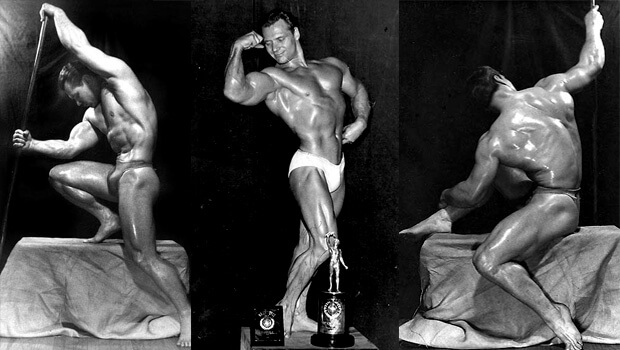
John Grimek in his prime.
A few other standouts of the same period were George Eiferman, Steve Stanko, Marvin Eder, and Jack Delinger, all who claimed FFMIs north of 26.
If a normalized FFMI of 25 were truly the best a natural weightlifter can get, skeptics say, how do you explain these men’s accomplishments? Clearly the ceiling is higher.
Or not.
Testosterone was first synthesized in 1935 and available for sale in 1937, right around the time many of the bodybuilders I just listed crossed the 25 FFMI threshold.
Unsurprisingly, the normalized FFMI of Mr. America winners also started surpassing 25 more and more after the 1940s.
You could say this was due to improvements in training and nutrition, the increasing popularity of bodybuilding, and other factors, but no matter how you slice it, it’s highly unlikely anything but drugs could produce such a marked increase in muscularity in such a short period of time.
I mean, are we really to believe that it’s merely a coincidence that normalized FFMIs made a quantum leap right after the invention and proliferation of the world’s most powerful muscle-building drug?
Occam’s razor, anyone?
Let’s look at John Grimek again to see why we should be highly skeptical.
According to records fastidiously compiled by Terry and Janice Todd, husband-and-wife pioneers of powerlifting and professors at the University of Texas, John Grimek achieved a normalized FFMI of 24 in 1940.
Grimek was already a seasoned bodybuilder at this point and had likely achieved most of his genetic potential for muscle growth, yet just one year later in 1941, his normalized FFMI skyrocketed to 27.
That’s not particularly striking until you crunch the numbers and realize that to increase his normalized FFMI by 3 points, Grimek had to gain damn near 25 pounds of muscle. In a year. As an advanced weightlifter with an already impressively muscular physique.
He did that naturally?
A later reanalysis using different methods by the Todds pegged his normalized FFMI at 27 in 1940 and 32 in 1941, but that still means he gained around 27 pounds of muscle in a year.
To my knowledge (and if I’m wrong, feel free to enlighten me in the comments), this kind of progress has never occurred anywhere without a lot of drugs. It’s simply unbelievable. As in you shouldn’t believe it.
Another common postulate used to undermine my position is that if sumo wrestlers and super heavyweight strongmen and powerlifters reduced their body fat levels, they’d have FFMIs far above 25.
For this to even matter, you’d have to first assume most of these men aren’t using steroids, which would be asinine.
First of all, steroids don’t just help you get bigger and leaner. They also help you recover faster after workouts and increase your strength, power, and even endurance.
In other words, any athlete who can benefit from being bigger, stronger, faster, and more physically resilient can benefit from steroids. In other words, just about every professional athlete in the world has good reasons to dope.
Steroids are attractive to powerlifters and strongmen because after about 5 years of consistently correct training, you’ll have more or less maxed out your potential for muscle and strength gains.
At this point, the only way to get much stronger is to gain a considerable amount of muscle, and that simply can’t be done without drugs. Not only that, but many of your competitors will be using steroids, so if you have any ambitions in the sport, you’ll need to as well.
And in the case of sumo wrestlers, they live and die by how big, heavy, and strong they are, so yeah, steroids should be right up their alley.
Let’s play Devil’s advocate and pretend I’m wrong about all of that. Let’s assume for the sake of argument that steroid use is indeed rare among sumo wrestlers, strongmen, and powerlifters. Does the theory that their normalized FFMIs would exceed 25 if they got lean pan out?
Not really.
A study conducted by scientists at Ibaraki University measured the body fat, lean body mass, and FFMI of 36 professional sumo wrestlers, and found that many of them had a normalized FFMI of around 30. The biggest one had a normalized FFMI of 34.6 at an estimated 33{740fcf70e3ac1f1193a1b542e1c9e953922ad085105f0bf8299e70261e238f62} body fat.
Another study conducted by scientists at the University of Mississippi on the world’s strongest raw powerlifter (someone who lifts without the assistance of straps or suits), Ray Williams, found he had a normalized FFMI of 41 at an estimated 25{740fcf70e3ac1f1193a1b542e1c9e953922ad085105f0bf8299e70261e238f62} body fat.
If you took those numbers at face value, you’d conclude (correctly) that their normalized FFMIs would be significantly higher than 25 if they reduced their body fat levels.
You can’t, however, because if you take one look at your average sumo wrestler or super heavyweight powerlifter like Ray Williams, you know these body fat measurements are suspiciously low.
For example, here are two of the best sumo wrestlers in the world, who are similar in height and weight to the wrestlers analyzed in the study mentioned above:
And here’s a picture of Ray Williams:
If you’ve read my article on estimating body fat percentage, you know all three of these gentlemen are closer to 35 to 40{740fcf70e3ac1f1193a1b542e1c9e953922ad085105f0bf8299e70261e238f62} body fat, not 25 or 30{740fcf70e3ac1f1193a1b542e1c9e953922ad085105f0bf8299e70261e238f62}. This matters because it means they’d have lower normalized FFMIs if they dieted down.
Let’s take Ray Williams as an example.
If we assume he has a body fat percentage of 35{740fcf70e3ac1f1193a1b542e1c9e953922ad085105f0bf8299e70261e238f62} instead of 25{740fcf70e3ac1f1193a1b542e1c9e953922ad085105f0bf8299e70261e238f62}, that drops his normalized FFMI to 35 instead of 41.
There’s another factor to consider that would likely decrease his normalized FFMI even further.
Scientists have known for a long time that as people gain body fat, they also gain a large amount of fat-free mass in the form of connective tissue, water, and other components of fat cells.
This is technically known as “nonessential fat-free mass,” and you can think of it as the infrastructure that supports and nourishes fat cells.
According to some estimates, up to 25{740fcf70e3ac1f1193a1b542e1c9e953922ad085105f0bf8299e70261e238f62} of the weight you gain as you get fatter is nonessential fat-free mass.
This is important because FFMI doesn’t distinguish between muscle tissue and these other substances. As a result, if someone were to gain 100 pounds from overeating, they could also gain up to 25 pounds of nonessential fat-free mass. This means their FFMI would be misleadingly high for the purpose of analyzing their body composition.
The same rule applies to weight loss as well.
If someone like Ray Williams were to lose a lot of body fat, he’d also lose quite a bit of nonessential fat-free mass. This would shave off several points from his normalized FFMI, pushing him closer to the 25 FFMI cutoff.
For instance, if we assume that about 25{740fcf70e3ac1f1193a1b542e1c9e953922ad085105f0bf8299e70261e238f62} of Williams’s “fat-free mass” is in fact connective tissue, water, and such, and we run his numbers again, his normalized FFMI is 26, a much more realistic estimate.
And remember: he’s the best raw powerlifter in the world so we can’t rule out drug use, regardless of what he claims.
So, here’s the bottom line:
- Bodybuilders of the “drug-free era” (~1940 to 1960) were likely not drug-free. Testosterone wasn’t as mainstream as it is now, but it’s very likely that top-tier bodybuilders were quick to take advantage of it.
- Record keeping during this time was notoriously poor, and in many cases, normalized FFMIs were calculated using unrealistically low body fat levels, usually around 5{740fcf70e3ac1f1193a1b542e1c9e953922ad085105f0bf8299e70261e238f62}. In reality, most of the men were closer to 10{740fcf70e3ac1f1193a1b542e1c9e953922ad085105f0bf8299e70261e238f62} body fat, which would slightly reduce their normalized FFMIs, but not enough to invalidate everything we’ve just discussed.
- Even if you insist most of the old school lifters were au naturel, only eight are on record with a normalized FFMI over 26 and only three exceeded 27. That means about 1{740fcf70e3ac1f1193a1b542e1c9e953922ad085105f0bf8299e70261e238f62} of the top 1{740fcf70e3ac1f1193a1b542e1c9e953922ad085105f0bf8299e70261e238f62} of dedicated weightlifters of this era achieved a normalized FFMI over 25, so why should we assume that just about anyone can now do it too?
- Athletes with large amounts of body fat such as sumo wrestlers, strongmen, powerlifters, and NFL linemen often have a normalized FFMI over 25, but this is primarily because FFMI calculators overestimate the muscularity of fat people. If they were to cut down to 10{740fcf70e3ac1f1193a1b542e1c9e953922ad085105f0bf8299e70261e238f62} body fat their numbers would look far more reasonable. It’s also likely many of these athletes are on drugs.
- The normalized FFMI cutoff of 25 isn’t a hard-and-fast, “everyone, everywhere, anytime” rule. It’s entirely possible that genetic freaks have attained a normalized FFMIs above 25 naturally, but they’re rare exceptions. Based on all the available data, it’s fair to say that virtually everybody who picks up a barbell is capable of achieving an FFMI in the 22 to 23 range, and virtually nobody will see 24 or beyond without steroids.
- Many current and past steroid users have a normalized FFMI below 25. Some have sub-par genetics, some take smaller doses, some don’t train intensely or frequently enough, some don’t eat well or sleep enough, some don’t want to be that big, and some (“influencers,” usually) even stage-manage their FFMIs by lying about their height, weight, and body fat percentage to avoid being pegged as drug users.
So, now that we’ve learned the lay of the land, let’s circle back to the question posed in the beginning of this section:
How can you tell if someone is natty or not? Here’s what the evidence says:
- If someone’s FFMI is over 25, it’s almost certain they’re taking or have taken steroids.
- If someone’s FFMI is between 24 and 25, then it’s likely they’re taking or have taken steroids.
- If someone’s FFMI is between 22 to 23 and they’ve been training consistently for 3+ years, they may be natural.
- If someone’s FFMI is between 21 to 22, they may be natural as well.
- If someone’s FFMI is between 18 to 21, they likely don’t even lift so who cares. 🙂
(And remember that we’re talking just about men here. Unfortunately, there’s no data on the correlation between steroid use and FFMI in women. It’s fair to assume, however, that their ceiling is significantly lower than men’s.)
If you’re unsure why I said people with FFMIs below 25 “may” be natural, the answer is simple:
There are plenty of guys using steroids with FFMIs below 25 for the reasons given earlier. That’s why you have to consider factors other than FFMI when determining whether someone is likely using drugs or not, including . . .
They’re the trifecta of bodybuilding: big, lean, and strong.
A common joke among natural bodybuilders is you get to pick two of the following three options:
- You can be big.
- You can be lean.
- You can be strong.
If you want all three, you need to take steroids.
It’s not entirely accurate—if you’re lean and strong you’re probably fairly big as well—but it alludes to reality:
If you want to be big and strong, forget about being lean, and if you want to be big and lean, forget about being strong. And let’s be honest: if you want to be big and lean, you probably can’t be “big,” but something more akin to “not small.”
More importantly, no matter what you do in the kitchen and gym, you’ll never be able to stay big, lean, and strong by any worthy standards.
This is why jacked, shredded dudes who press, pull, and squat gargantuan amounts of weight are basically dripping in steroids.
And just to put numbers to this, if we consult commonly accepted strength standards for a 200-pound man, this would look something like . . .
- Benching over 400 pounds
- Squatting over 600 pounds
- Deadlifting over 700 pounds
. . . and for a 160-pound woman it would look like . . .
- Benching over 200 pounds
- Squatting over 400 pounds
- Deadlifting over 500 pounds
. . . while also sporting supersized muscles and body fat levels underneath 10{740fcf70e3ac1f1193a1b542e1c9e953922ad085105f0bf8299e70261e238f62} for men and 20{740fcf70e3ac1f1193a1b542e1c9e953922ad085105f0bf8299e70261e238f62} for women.
And I know, strength doesn’t perfectly correlate with muscularity and there are people who can get freakishly strong without taking drugs, but in the final analysis, the biggest people in the gym tend to be the strongest.
And when the biggest and strongest people are also the leanest, they’re taking steroids.
They suddenly got way stronger.
A large jump in strength in an intermediate or advanced weightlifter is a major indicator of steroid use.
After your first couple years of proper training, you’ll be lucky to add 50 total pounds to your big compound lifts in a single year. And once you’ve been training for 7 to 10 years, adding 10 pounds to your bench press, squat, or deadlift in one year is cause for celebration (seriously).
And just for the sake of contrast, in a steroid study we reviewed earlier, lifters with about one year of training experience took steroids and added 132 pounds to their squat and bench press in just 10 weeks. That’s absurd and shows just how much of a difference drugs can make.
So if an experienced lifter “naturally” adds 50 pounds or more to a major exercise in one year or less, well, let’s just say we have a word for that in English. It’s called, “suspicious.” As in, suspiciously full of shit.
They have a massive upper chest, shoulders, and traps.
This is a reliable sign of drug use because these areas of the body have a lot of androgen receptors, which are special types of proteins in cells that respond to anabolic hormones like testosterone in the blood.
When you artificially raise anabolic hormone levels by taking drugs like testosterone, these receptors go into overdrive and cause these muscle groups to develop much faster than others.
Here’s a good example of this look, which I pulled from a steroid forum where guys openly talk about their cycles:
This is also true for women, although female drug users tend to be easier to spot using the next criterion.
They’re shredded, dry, and full, with amazing muscle separation.
You can get very lean and dry naturally, but you can’t achieve that look of being carved out of marble with full, striated, “3D” muscles that “pop” off your bones.
For example, here’s a shot of me at about 183 pounds and 7{740fcf70e3ac1f1193a1b542e1c9e953922ad085105f0bf8299e70261e238f62} body fat:
This is more or less the best I can possibly look without drugs. And while I think I did a good job getting lean and preserving muscle, compare it to the following picture of a well-known bodybuilder and fitness model:
Oh, and he stays like that more or less year round. I guess I just don’t have enough #dedication.
This is particularly apparent with female steroid users who are able to maintain absurdly low body fat percentages compared to what most women can achieve naturally:
This level of leanness, size, and separation simply isn’t achievable for women without steroids, and fat burners like clenbuterol are often involved as well.
They stay extremely lean, full, and dry year round.
This is a corollary to the previous point.
With proper training and dieting, you can naturally get lean and dry with outstanding muscle separation, but you can’t maintain that look for long. Trust me, I’ve tried.
The problems are many: you can’t eat enough food to feel good, your training goes to shit, your sleep suffers, your sex drive plummets, and your energy levels bottom out. The human body just wasn’t meant to stay that lean.
The right drugs change all of this. All of a sudden, you can stay absolutely shredded while eating piles of food, sleeping far less than recommended, and pushing yourself through grueling workouts.
If you have good genetics, maintaining 10{740fcf70e3ac1f1193a1b542e1c9e953922ad085105f0bf8299e70261e238f62} body fat for men and 20{740fcf70e3ac1f1193a1b542e1c9e953922ad085105f0bf8299e70261e238f62} for women year round is possible, but it requires that you carefully watch what you eat and how much you exercise.
Staying leaner while also enjoying significant size, energy, and conditioning, however, is only possible with some “chemical assistance.”
They have excellent overall development and proportions.
As I mentioned earlier in this article, it’s rare to find a natural lifter who has perfect size, symmetry, and definition in all major muscle groups.
With steroid users, however, this becomes relatively common.
I’m a good example of this rule. While my upper body, glutes, and quads are fairly well developed and proportional, my calves are still relatively small and my shoulders are barely keeping up.
One of the guys who works with me has a similar issue: His quads, calves, and chest are well developed, but his back, shoulders, and arms are less than impressive.
If we were to take drugs, though, it wouldn’t take long for us to fill in our lagging muscle groups (and this is the only way my calves would ever match the sizes of my arms, which is considered ideal among bodybuilders).
Why? Two reasons:
- Every cell in the body has androgen receptors and artificially raising your androgen levels forces even stubborn muscle groups like the calves, shoulders, and arms to grow.
- Steroid users can more easily “sculpt” their bodies by neglecting their strong points (which will stay big) and hammering their weak points (which will grow rapidly).
They have bad acne and male-pattern baldness.
Some people are genetically prone to breakouts and baldness, but steroids can aggravate these problems.
This why acne-covered chests and backs and receding hairlines are so prevalent among bodybuilders, and particularly those who are huge, shredded, dry, and full.
To hide this, steroid users often photoshop and filter out pimples and acne scars in pictures they post online, but every so often a candid shot makes its way into the wild and looks something like this:
It’s also common for steroid users to have unusually thick, fast-growing facial and chest hair—another side effect of the masculinizing properties of anabolic drugs.
Some More Perspective on Expectations
By now, you’ve probably realized that the highest your normalized FFMI will probably ever get is in the range of 22 to 24, depending on how you eat, train, recover, and how your body is hardwired.
For instance, here’s me after nearly 16 years of training, with the last 7 or so particularly dialed in:
And guess what my normalized FFMI is?
About 23, or “frail” by Instagram standards. And I’m okay with that. I like the way I look, feel, and perform, and I like that I don’t need to inject and ingest a cocktail of chemicals every week and then lie about it to enjoy my body and trick people into buying my trinkets.
You can do the same.
Regardless of where your normalized FFMI will ultimately settle, you can rest assured you’re going to have the type of body most people would kill for. No drugs necessary.
How to Gain Muscle and Strength Fast
If you want to reach your natural potential for muscle growth, you need an effective diet and training plan.
You want to gain muscle and not just get fat, and you have to do more than just “eat big” to do that.
Fortunately, though, it’s not complicated. There are just five simple steps.
- Eat slightly more calories than you burn.
- Eat a high-protein and high-carb diet.
- Don’t cheat/overeat too much.
- Do a lot of heavy compound weightlifting.
- Take the right supplements.
Let’s get to it.
(And if you prefer a 13-minute video overview, just click below.)
1. Eat slightly more calories than you burn.
The biggest mistake people that “can’t gain weight” make is not eating enough calories.
Their natural appetites just aren’t up to it.
And by “it,” I mean consistently eating more calories than they burn, which is what you need to do to gain muscle and strength as quickly as possible.
There are various reasons for this, mainly physiological, but we don’t have to get into them here. All you need to know is that your body’s “muscle-building machinery” just works best when energy is abundant.
Another major mistake that “hardgainers” often make is the opposite of the above: eating way too much.
They assume that if slightly overeating is better for gaining muscle, then going gorging themselves silly or drinking a gallon of milk a day is much better.
Unfortunately, it’s not.
You can’t force your muscles to grow faster by drowning them in calories, because beyond a certain point, they stop fueling muscle growth and just make you fatter.
That’s why a slight calorie surplus of 10 to 15{740fcf70e3ac1f1193a1b542e1c9e953922ad085105f0bf8299e70261e238f62} is just as conducive to muscle growth as a larger surplus of 30{740fcf70e3ac1f1193a1b542e1c9e953922ad085105f0bf8299e70261e238f62} or more.
That is, all you have to do to optimize muscle growth is eat just 10 to 15{740fcf70e3ac1f1193a1b542e1c9e953922ad085105f0bf8299e70261e238f62} more calories than you burn every day.
This is the point of diminishing returns, where increasing your calorie intake further contributes less and less to muscle building and more and more to fat gain.
And gaining too much fat does more than hurt your ego. It also makes it harder to build muscle by negatively impacting your insulin sensitivity, making it more likely that the calories you consume will be stored as fat, not muscle.
This is why you should shy away from “dirty bulking,” as bodybuilders call it, and opt to “lean bulk” instead.
This approach is a win-win because it allows you to maximize muscle growth and minimize fat gain.
And, just in case you’re curious, most people can gain muscle and fat at about a 1:1 ratio when they’re doing everything right.
In other words, if you gain a pound of muscle for every pound of fat while lean bulking, you’re doing a good job.
(Those with above-average genetics can gain slightly more muscle than fat, and those with below-average genetics may gain slightly more fat than muscle, but most people are in the middle.)
Want to know how many calories you should eat? Check out this article:
2. Eat a high-protein and high-carb diet.
You’ve probably heard that a high-protein diet is best for building muscle.
This is true, and that’s why there’s so much talk about protein in bodybuilding circles.
Protein provides your body with the raw materials necessary for muscle building (amino acids), so if you don’t eat enough, you’ll struggle to gain muscle.
What is “enough,” though?
It’s quite a bit more than most people are used to eating (but not quite as much as some people claim).
Research shows that eating about 1 gram of protein per pound of body weight per day is ideal for muscle gain.
If you’re very overweight (25{740fcf70e3ac1f1193a1b542e1c9e953922ad085105f0bf8299e70261e238f62}+ body fat in men and 30{740fcf70e3ac1f1193a1b542e1c9e953922ad085105f0bf8299e70261e238f62}+ in women), then this can be reduced to around 1 gram of protein per pound of fat-free mass per day.
Either way, it comes out to around 30 to 40{740fcf70e3ac1f1193a1b542e1c9e953922ad085105f0bf8299e70261e238f62} of total daily calories for most people.
Now, while there’s little debate on the importance of eating adequate protein, carbs are another story.
Low-carb diets are a “thing” these days, but they really don’t deserve the hype.
They don’t help you lose fat faster, and they most definitely don’t help you gain muscle faster, either.
To the contrary, eating plenty of carbs helps you gain muscle faster in two ways:
- It increases whole-body glycogen levels, which improves workout performance and enhances genetic signalling related to muscle growth.
- It keeps insulin levels generally higher, which lowers muscle breakdown rates and creates a more anabolic environment in the body.
This is why several studies have shown that high-carb diets are superior for gaining muscle and strength than low-carb ones.
So, here’s the bottom line:
If you want to gain muscle as quickly as possible, then you want to eat more and not less carbs.
A good starting place is to get 30 to 50{740fcf70e3ac1f1193a1b542e1c9e953922ad085105f0bf8299e70261e238f62} of your total daily calories from carbs.
Want to know more about how much protein and carbs you should eat? Check out this article:
3. Don’t cheat/overeat too much.
“I’m bulking, bro,” he says, as he eats a pile of candy and washes it down with a quart of chocolate milk.
Don’t be that guy (or gal). Don’t let your lean bulk go “dirty.”
It’s easy to loosen the reins when you’re not restricting calories to lose fat, and this is a mistake.
If you want to maximize muscle gain and minimize fat gain, you need to regulate your calories and macros almost as carefully when bulking as when cutting.
If you have too many cheat meals (or, worse, cheat days) while bulking, it’ll catch up with you sooner rather than later, because you will gain fat faster and faster, which will slow you down in the long run.
Eating too many high-sugar, highly processed, non-nutritious foods causes other problems, too.
For example . . .
- You can develop vitamin and mineral deficiencies that can lead to a number of health problems.
- Eating too many highly processed carbs is associated with an increased risk of chronic disease.
- The same goes for eating too much low-quality, highly processed meats.
- Eating even small amounts of trans fats raises your risk of heart disease, diabetes, infertility, and other undesirable conditions.
Many people also find it hard to break away from an uninhibited, gluttonous style of eating when it comes time to finally get rid of unwanted body fat, making it even more difficult to reach their desired body fat percentage.
Want to know more about how to cheat without ruining your diet? Check out this article:
4. Do a lot of heavy compound weightlifting.
If you don’t get the first three steps right, what you do in the gym won’t matter very much.
Proper dieting is just that important.
If you do, though, the right workout program will make a huge difference in how quickly you can gain weight and muscle.
And the best types of workout programs for natural weightlifters are those that focus on heavy compound exercises like the squat, deadlift, bench press, and military press.
Sure, you can gain muscle and strength in many different ways, but decades of scientific and anecdotal evidence have conclusively proven that this is the most effective approach.
The reason heavy compound weightlifting is so powerful is simple: it’s the best way to progressively overload your muscles.
And by “progressively overloading” your muscles, I mean forcing them to produce greater and greater levels of tension over time. This is the primary driver of muscle growth, and while there are several ways to do this, the most effective one is just getting stronger.
That’s why the strongest people in the gym are also generally the biggest, and if you want to build a great physique, why your primary goal should be increasing whole-body strength.
Want to know more about how to build a workout program that really works? Check out this article:
5. Take the right supplements.
I saved this for last because it’s the least important.
The truth is most supplements for building muscle and losing fat are worthless.
Unfortunately, no amount of pills and powders are going to make you muscular and lean.
That said, if you know how to drive muscle growth with proper dieting and exercise, certain supplements can accelerate the process.
Here are the ones I use and recommend:
Atlas Mass Gainer
In an ideal world, we’d get all of our daily calories from carefully prepared, nutritionally balanced meals, and we’d have the time to sit down, slow down, and savor each and every bite.
In the real world, though, we’re usually rushing from one obligation to another and often forget to eat anything, let alone the optimal foods for building muscle, losing fat, and staying healthy.
That’s why meal replacement and “weight gainer” supplements and protein bars and snacks are more popular than ever.
Unfortunately, most contain low-quality protein powders and large amounts of simple sugars and unnecessary junk.
That’s why I created Atlas.
It’s a delicious “weight gainer” (meal replacement) supplement that provides you with 38 grams of high-quality protein per serving, along with 51 grams of nutritious, food-based carbohydrates, and just 6 grams of natural fats, as well as 26 micronutrients, enzymes, and probiotics that help you feel and perform your best.
Atlas is also 100{740fcf70e3ac1f1193a1b542e1c9e953922ad085105f0bf8299e70261e238f62} naturally sweetened and flavored as well, and contains no chemical dyes, cheap fillers, or other unnecessary junk.
So, if you want to build muscle and lose fat as quickly as possible and improve the nutritional quality of your diet, you want to try Atlas today.
Recharge Post-Workout Supplement
Recharge is a 100{740fcf70e3ac1f1193a1b542e1c9e953922ad085105f0bf8299e70261e238f62} natural post-workout supplement that helps you gain muscle and strength faster, and recover better from your workouts.
Once it’s had time to accumulate in your muscles (about a week of use), the first thing you’re going to notice is increased strength and anaerobic endurance, less muscle soreness, and faster post-workout muscle recovery.
And the harder you can train in your workouts and the faster you can recover from them, the more muscle and strength you’re going to build over time.
Furthermore, Recharge doesn’t need to be cycled, which means it’s safe for long-term use, and its effects don’t diminish over time.
It’s also naturally sweetened and flavored and contains no artificial food dyes, fillers, or other unnecessary junk.
So, if you want to be able to push harder in the gym, train more frequently, and get more out of your workouts, you want to try Recharge today.
Whey+ Protein Powder
Whey protein powder is a staple in most athletes’ diets for good reason.
It’s digested quickly, it’s absorbed well, it has a fantastic amino acid profile, and it’s easy on the taste buds.
Not all whey proteins are created equal, though.
Whey concentrate protein powder, for example, can be as low as 30{740fcf70e3ac1f1193a1b542e1c9e953922ad085105f0bf8299e70261e238f62} protein by weight, and can also contain a considerable amount of fat and carbs.
And the more fat and carbs you’re drinking, the less you can actually enjoy in your food.
Whey isolate protein powder, on the other hand, is the purest whey protein you can buy. It’s 90{740fcf70e3ac1f1193a1b542e1c9e953922ad085105f0bf8299e70261e238f62}+ protein by weight and has almost no fat or carbs.
Another benefit of whey isolate is it contains no lactose, which means better digestibility and fewer upset stomachs.
Well, Whey+ is a 100{740fcf70e3ac1f1193a1b542e1c9e953922ad085105f0bf8299e70261e238f62} naturally sweetened and flavored whey isolate protein powder made from exceptionally high-quality milk from small dairy farms in Ireland.
It contains no GMOs, hormones, antibiotics, artificial food dyes, fillers, or other unnecessary junk, and it tastes delicious and mixes great.
So, if you want a clean, all-natural, and great tasting whey protein supplement that’s low in calories, carbs, and fat, you want to try Whey+ today.
Casein+ Protein Powder
Casein protein is probably second in popularity behind whey, and it’s also a protein found in milk. The curds that form as milk coagulates are casein.
Casein protein is digested slower than whey, causing a smaller spike in amino acids in the blood, but a steadier release over the course of several hours.
There’s an ongoing debate about whether supplementing with whey is better than casein for building muscle or vice versa, but here’s what most reputable experts agree on:
- Due to its rapid digestion and abundance of leucine, a 30-40 gram serving of whey is probably your best choice for post-workout protein.
- Due to its slow release of amino acids, casein is a great all-around protein supplement. While it may or may not be as optimal as whey for post-workout protein (the jury is still out on this), there is a growing body of evidence indicating that, when supplementing with powders, a slow-burning protein is the best overall choice for building muscle.
- Casein is a good protein to have before you go to bed, which can help with muscle recovery.
The best type of casein you can get is micellar casein. That’s because it’s produced in a way that preserves the small bundles of protein (micelles) that are responsible for its slow-digesting properties and often destroyed during traditional manufacturing processes.
That’s why when I set out to make my own casein powder (Casein+), I chose 100{740fcf70e3ac1f1193a1b542e1c9e953922ad085105f0bf8299e70261e238f62} micellar casein made from exceptionally high-quality milk from small, sustainable dairy farms in Ireland.
It’s also 100{740fcf70e3ac1f1193a1b542e1c9e953922ad085105f0bf8299e70261e238f62} naturally sweetened and flavored, and is the best-tasting all-natural micellar casein to boot.
If you want a clean, all-natural, delicious micellar casein protein powder that’s low in calories, carbs, and fat, and supports muscle-building with a sustained release of amino acids for hours and hours, you want to try Casein+ today.
Pulse Pre-Workout
Is your pre-workout simply not working anymore?
Are you sick and tired of pre-workout drinks that make you sick and tired?
Have you had enough of upset stomachs, jitters, nausea, and the dreaded post-workout crash?
Do you wish your pre-workout supplement gave you sustained energy and more focus and motivation to train? Do you wish it gave you noticeably better workouts and helped you hit PRs?
If you’re nodding your head, then you’re going to love Pulse.
It increases energy, improves mood, sharpens mental focus, increases strength and endurance, and reduces fatigue . . . without unwanted side effects or the dreaded post-workout crash.
It’s also naturally sweetened and flavored and contains no artificial food dyes, fillers, or other unnecessary junk.
Lastly, it contains no proprietary blends and each serving delivers nearly 20 grams of active ingredients scientifically proven to improve performance.
So, if you want to feel focused, tireless, and powerful in your workouts . . . and if you want to say goodbye to the pre-workout jitters, upset stomachs, and crashes for good . . . you want to try Pulse today.
The Bottom Line on How Much Muscle You Can Gain Naturally
Everyone has a genetic limit to how much muscle they can gain.
The best predictor of this seems to be the size of our skeleton, which we can estimate using our wrist and ankle circumference measurements.
Although testosterone is the primary hormonal driver of muscle growth, fluctuations within the physiological normal range don’t significantly help or hurt muscle growth in the long run.
The easiest way to estimate your potential for muscularity is to plug your numbers into the calculator in this article, and subtract 5{740fcf70e3ac1f1193a1b542e1c9e953922ad085105f0bf8299e70261e238f62} from the answer.
You may not be impressed by the number you see, but the good news is you probably don’t have to build as much muscle as you think to have the body you really want.
If you’re a guy, once you’ve added about 20 pounds of muscle and reduced your body fat to about 10{740fcf70e3ac1f1193a1b542e1c9e953922ad085105f0bf8299e70261e238f62}, you’re going to look fantastic. And if you’re a woman, 10 pounds of muscle in the right places with your body fat around 20{740fcf70e3ac1f1193a1b542e1c9e953922ad085105f0bf8299e70261e238f62} is more or less ideal by most female standards.
And anybody can do those things.
Whatever you do, don’t fall into the trap of comparing yourself to the unrealistic expectations set by steroid users.
The best way to determine if a guy is on steroids is to calculate his normalized FFMI. If it’s over 25, then he’s almost certainly on or has used steroids, and if it’s right there (24 or 25), he should probably be considered guilty until proven innocent.
Most natural male lifters can achieve a normalized FFMI of 22 to 23, and a small handful of gifted ones can approach 25.
Unfortunately, it’s not clear what the normalized FFMI natural cutoff is for women, and there’s no evidence-based way to detect female drug use yet.
So, if you want to reach your natural genetic potential for muscle growth as soon as possible, follow these five steps:
- Eat slightly more calories than you burn.
- Eat a high-protein and high-carb diet.
- Don’t cheat/overeat too much.
- Do a lot of heavy compound weightlifting.
- Take the right supplements.
Do that, and I promise you’ll be happy with the results.
***
This article is from the new second edition of my bestselling fitness book for experienced weightlifters, Beyond Bigger Leaner Stronger, which is now live everywhere you can buy books online.
Also, to celebrate the book’s release, I’m giving away over $6,000 of glorious goodies, including a 30-minute Zoom call with yours unruly, Vitamix blender, Hypervolt Bluetooth massage gun, and more. Click here to learn how to win.
If you liked this article, please share it on Facebook, Twitter, or wherever you like to hang out online! 🙂
What’s your take on how much muscle you can build naturally? Have anything else to share? Let me know in the comments below!
+ Scientific References
- A L Goldberg, J D Etlinger, D F Goldspink, C. J. (n.d.). Mechanism of Work-Induced Hypertrophy of Skeletal Muscle – PubMed. Retrieved July 8, 2020, from https://pubmed.ncbi.nlm.nih.gov/128681/
- Jorge E Chavarro 1, Janet W Rich-Edwards, Bernard A Rosner, W. C. W. (n.d.). Dietary Fatty Acid Intakes and the Risk of Ovulatory Infertility – PubMed. Retrieved July 8, 2020, from https://pubmed.ncbi.nlm.nih.gov/17209201/
- J Salmerón 1, F B Hu, J E Manson, M J Stampfer, G A Colditz, E B Rimm, W. C. W. (n.d.). Dietary Fat Intake and Risk of Type 2 Diabetes in Women – PubMed. Retrieved July 8, 2020, from https://pubmed.ncbi.nlm.nih.gov/11382654/
- Santarelli, R. L., Pierre, F., & Corpet, D. E. (2008). Processed meat and colorectal cancer: A review of epidemiologic and experimental evidence. In Nutrition and Cancer (Vol. 60, Issue 2, pp. 131–144). Nutr Cancer. https://doi.org/10.1080/01635580701684872
- Mulholland, H. G., Murray, L. J., Cardwell, C. R., & Cantwell, M. M. (2009). Glycemic index, glycemic load, and risk of digestive tract neoplasms: a systematic review and meta-analysis. The American Journal of Clinical Nutrition, 89(2), 568–576. https://doi.org/10.3945/ajcn.2008.26823
- Gibson, S. A. (2007). Dietary sugars intake and micronutrient adequacy: A systematic review of the evidence. In Nutrition Research Reviews (Vol. 20, Issue 2, pp. 121–131). Nutr Res Rev. https://doi.org/10.1017/S0954422407797846
- Howarth, K. R., Phillips, S. M., MacDonald, M. J., Richards, D., Moreau, N. A., & Gibala, M. J. (2010). Effect of glycogen availability on human skeletal muscle protein turnover during exercise and recovery. Journal of Applied Physiology, 109(2), 431–438. https://doi.org/10.1152/japplphysiol.00108.2009
- Denne, S. C., Liechty, E. A., Liu, Y. M., Brechtel, G., & Baron, A. D. (1991). Proteolysis in skeletal muscle and whole body in response to euglycemic hyperinsulinemia in normal adults. American Journal of Physiology – Endocrinology and Metabolism, 261(6 24-6). https://doi.org/10.1152/ajpendo.1991.261.6.e809
- Creer, A., Gallagher, P., Slivka, D., Jemiolo, B., Fink, W., & Trappe, S. (2005). Influence of muscle glycogen availability on ERK1/2 and Akt signaling after resistance exercise in human skeletal muscle. Journal of Applied Physiology, 99(3), 950–956. https://doi.org/10.1152/japplphysiol.00110.2005
- Burke, L. M., Kiens, B., & Ivy, J. L. (2004). Carbohydrates and fat for training and recovery. Journal of Sports Sciences, 22(1), 15–30. https://doi.org/10.1080/0264041031000140527
- Carol S Johnston 1, Sherrie L Tjonn, Pamela D Swan, Andrea White, Heather Hutchins, B. S. (n.d.). Ketogenic Low-Carbohydrate Diets Have No Metabolic Advantage Over Nonketogenic Low-Carbohydrate Diets – PubMed. Retrieved July 8, 2020, from https://pubmed.ncbi.nlm.nih.gov/16685046/
- Helms, E. R., Aragon, A. A., & Fitschen, P. J. (2014). Evidence-based recommendations for natural bodybuilding contest preparation: Nutrition and supplementation. In Journal of the International Society of Sports Nutrition (Vol. 11, Issue 1, pp. 1–20). BioMed Central Ltd. https://doi.org/10.1186/1550-2783-11-20
- Tipton, K. D., & Ferrando, A. A. (2008). Improving muscle mass: Response of muscle metabolism to exercise, nutrition and anabolic agents. Essays in Biochemistry, 44, 85–98. https://doi.org/10.1042/BSE0440085
- Wang, X., Hu, Z., Hu, J., Du, J., & Mitch, W. E. (2006). Insulin resistance accelerates muscle protein degradation: Activation of the ubiquitin-proteasome pathway by defects in muscle cell signaling. Endocrinology, 147(9), 4160–4168. https://doi.org/10.1210/en.2006-0251
- Kadi, F., Bonnerud, P., Eriksson, A., & Thornell, L. E. (2000). The expression of androgen receptors in human neck and limb muscles: Effects of training and self-administration of androgenic-anabolic steroids. Histochemistry and Cell Biology, 113(1), 25–29. https://doi.org/10.1007/s004180050003
- Bhasin, S., Storer, T. W., Berman, N., Callegari, C., Clevenger, B., Phillips, J., Bunnell, T. J., Tricker, R., Shirazi, A., & Casaburi, R. (1996). The Effects of Supraphysiologic Doses of Testosterone on Muscle Size and Strength in Normal Men. New England Journal of Medicine, 335(1), 1–7. https://doi.org/10.1056/NEJM199607043350101
- Kyle, U. G., Morabia, A., Schutz, Y., & Pichard, C. (2004). Sedentarism affects body fat mass index and fat-free mass index in adults aged 18 to 98 years. Nutrition, 20(3), 255–260. https://doi.org/10.1016/j.nut.2003.11.019
- E Nieschlag. (n.d.). The history of testosterone | SFE2005. Retrieved July 8, 2020, from https://www.endocrine-abstracts.org/ea/0010/ea0010s2
- Hall, K. D. (2007). Body fat and fat-free mass inter-relationships: Forbes’s theory revisited. British Journal of Nutrition, 97(6), 1059–1063. https://doi.org/10.1017/S0007114507691946
- A D Martin 1, M Z Daniel, D T Drinkwater, J. P. C. (n.d.). Adipose Tissue Density, Estimated Adipose Lipid Fraction and Whole Body Adiposity in Male Cadavers – PubMed. Retrieved July 8, 2020, from https://pubmed.ncbi.nlm.nih.gov/8148928/
- Abe, T., Buckner, S. L., Mattocks, K. T., Jessee, M. B., Dankel, S. J., Mouser, J. G., Bell, Z. W., & Loenneke, J. P. (2018). Skeletal muscle mass and architecture of the world’s strongest raw powerlifter: A case study. Asian Journal of Sports Medicine, 9(2). https://doi.org/10.5812/asjsm.61763
- Hattori, K., Kondo, M., Abe, T., Tanaka, S., & Fukunaga, T. (1999). Hierarchical differences in body composition of professional Sumo wrestlers. Annals of Human Biology, 26(2), 179–184. https://doi.org/10.1080/030144699282886
- Lietzke, M. H. (1956). Relation between weight-lifting totals and body weight. Science, 124(3220), 486–487. https://doi.org/10.1126/science.124.3220.486
- Kouri, E. M., Pope, H. G., Katz, D. L., & Oliva, P. (1995). Fat-free mass index in users and nonusers of anabolic-androgenic steroids. Clinical Journal of Sport Medicine, 5(4), 223–228. https://doi.org/10.1097/00042752-199510000-00003
- Kadi, F., Eriksson, A., Holmner, S., & Thornell, L. E. (1999). Effects of anabolic steroids on the muscle cells of strength-trained athletes. Medicine and Science in Sports and Exercise, 31(11), 1528–1534. https://doi.org/10.1097/00005768-199911000-00006
- Murach, K. A., Englund, D. A., Dupont-Versteegden, E. E., McCarthy, J. J., & Peterson, C. A. (2018). Myonuclear domain flexibility challenges rigid assumptions on satellite cell contribution to skeletal muscle fiber hypertrophy. In Frontiers in Physiology (Vol. 9, Issue MAY). Frontiers Media S.A. https://doi.org/10.3389/fphys.2018.00635
- Teixeira, C. E., & Duarte, J. A. (2011). Myonuclear domain in skeletal muscle fibers. A critical review. Archives of Exercise in Health and Disease, 2(2), 92–101. https://doi.org/10.5628/aehd.v2i2.24
- Kadi, F., Eriksson, A., Holmner, S., & Thornell, L. E. (1999). Effects of anabolic steroids on the muscle cells of strength-trained athletes. Medicine and Science in Sports and Exercise, 31(11), 1528–1534. https://doi.org/10.1097/00005768-199911000-00006
- Kouri, E. M., Pope, H. G., Katz, D. L., & Oliva, P. (1995). Fat-free mass index in users and nonusers of anabolic-androgenic steroids. Clinical Journal of Sport Medicine, 5(4), 223–228. https://doi.org/10.1097/00042752-199510000-00003
- Kanayama, G., Boynes, M., Hudson, J. I., Field, A. E., & Pope, H. G. (2007). Anabolic steroid abuse among teenage girls: An illusory problem? Drug and Alcohol Dependence, 88(2–3), 156–162. https://doi.org/10.1016/j.drugalcdep.2006.10.013
- Cohen, J., Collins, R., Darkes, J., & Gwartney, D. (2007). A league of their own: Demographics, motivations and patterns of use of 1,955 male adult non-medical anabolic steroid users in the United States. Journal of the International Society of Sports Nutrition, 4, 12. https://doi.org/10.1186/1550-2783-4-12
- Storer, T. W., Magliano, L., Woodhouse, L., Lee, M. L., Dzekov, C., Dzekov, J., Casaburi, R., & Bhasin, S. (2003). Testosterone dose-dependently increases maximal voluntary strength and leg power, but does not affect fatigability or specific tension. Journal of Clinical Endocrinology and Metabolism, 88(4), 1478–1485. https://doi.org/10.1210/jc.2002-021231
- Bhasin, S., Storer, T. W., Berman, N., Callegari, C., Clevenger, B., Phillips, J., Bunnell, T. J., Tricker, R., Shirazi, A., & Casaburi, R. (1996). The Effects of Supraphysiologic Doses of Testosterone on Muscle Size and Strength in Normal Men. New England Journal of Medicine, 335(1), 1–7. https://doi.org/10.1056/NEJM199607043350101
- Forbes, G. B. (1985). The effect of anabolic steroids on lean body mass: The dose response curve. Metabolism, 34(6), 571–573. https://doi.org/10.1016/0026-0495(85)90196-9
- Blazevich, A. J., Cannavan, D., Waugh, C. M., Miller, S. C., Thorlund, J. B., Aagaard, P., & Kay, A. D. (2014). Range of motion, neuromechanical, and architectural adaptations to plantar flexor stretch training in humans. Journal of Applied Physiology, 117(5), 452–462. https://doi.org/10.1152/japplphysiol.00204.2014
- Research, I. of M. (US) C. on M. N., Carlson-Newberry, S. J., & Costello, R. B. (1997). Dual-Energy X-Ray Absorptiometry: Research Issues and Equipment. https://www.ncbi.nlm.nih.gov/books/NBK233779/
- Kerr, D. A. (n.d.). An anthropometric method for fractionation of skin, adipose, bone, muscle and residual tissue masses in males and females age 6 to 77 years | Summit. Retrieved July 8, 2020, from http://summit.sfu.ca/item/5139
- Holway, F. E., & Garavaglia, R. (2009). Kinanthropometry of group I rugby players in Buenos Aires, Argentina. Journal of Sports Sciences, 27(11), 1211–1220. https://doi.org/10.1080/02640410903207408
- Holway, F. E., & Veitía, W. C. (2011). Height-adjusted Differences In Body Composition Tissues In Elite Male Cuban Weight-category Athletes. Medicine & Science in Sports & Exercise, 43(Suppl 1), 13. https://doi.org/10.1249/01.mss.0000402707.52225.27
- Van Etten, L. M. L. A., & Verstappen, F. T. J. (1994). Effect of body build on weight-training-induced adaptations in body composition and muscular strength. Medicine and Science in Sports and Exercise, 26(4), 515–521. https://doi.org/10.1249/00005768-199404000-00018
- Jeevanandam, S., & Muthu, P. K. (2016). 2D:4D Ratio and its Implications in Medicine. JOURNAL OF CLINICAL AND DIAGNOSTIC RESEARCH, 10(12), CM01. www.jcdr.net
- William Cameron Chumlea, Wayne Wisemandle, Shumei S Guo, R. M. S. (n.d.). Relations between frame size and body composition and bone mineral status | The American Journal of Clinical Nutrition | Oxford Academic. Retrieved July 8, 2020, from https://academic.oup.com/ajcn/article/75/6/1012/4689430
- Webborn, N., Williams, A., McNamee, M., Bouchard, C., Pitsiladis, Y., Ahmetov, I., Ashley, E., Byrne, N., Camporesi, S., Collins, M., Dijkstra, P., Eynon, N., Fuku, N., Garton, F. C., Hoppe, N., Holm, S., Kaye, J., Klissouras, V., Lucia, A., … Wang, G. (2015). Direct-to-consumer genetic testing for predicting sports performance and talent identification: Consensus statement. British Journal of Sports Medicine, 49(23), 1486–1491. https://doi.org/10.1136/bjsports-2015-095343
- Dandoy, C., & Gereige, R. S. (2012). Performance-enhancing drugs. In Pediatrics in Review (Vol. 33, Issue 6, pp. 265–272). American Academy of Pediatrics. https://doi.org/10.1542/pir.33-6-265
- Res, P. T., Groen, B., Pennings, B., Beelen, M., Wallis, G. A., Gijsen, A. P., Senden, J. M. G., & Van Loon, L. J. C. (2012). Protein ingestion before sleep improves postexercise overnight recovery. Medicine and Science in Sports and Exercise, 44(8), 1560–1569. https://doi.org/10.1249/MSS.0b013e31824cc363
- Boirie, Y., Dangin, M., Gachon, P., Vasson, M. P., Maubois, J. L., & Beaufrère, B. (1997). Slow and fast dietary proteins differently modulate postprandial protein accretion. Proceedings of the National Academy of Sciences of the United States of America, 94(26), 14930–14935. https://doi.org/10.1073/pnas.94.26.14930
- West, D. W. D., Burd, N. A., Coffey, V. G., Baker, S. K., Burke, L. M., Hawley, J. A., Moore, D. R., Stellingwerff, T., & Phillips, S. M. (2011). Rapid aminoacidemia enhances myofibrillar protein synthesis and anabolic intramuscular signaling responses after resistance exercise. American Journal of Clinical Nutrition, 94(3), 795–803. https://doi.org/10.3945/ajcn.111.013722
- Tipton, K. D., Elliott, T. A., Cree, M. G., Wolf, S. E., Sanford, A. P., & Wolfe, R. R. (2004). Ingestion of casein and whey prosteins result in muscle anabolism after resistance exercise. Medicine and Science in Sports and Exercise, 36(12), 2073–2081. https://doi.org/10.1249/01.MSS.0000147582.99810.C5
- Boirie, Y., Dangin, M., Gachon, P., Vasson, M. P., Maubois, J. L., & Beaufrère, B. (1997). Slow and fast dietary proteins differently modulate postprandial protein accretion. Proceedings of the National Academy of Sciences of the United States of America, 94(26), 14930–14935. https://doi.org/10.1073/pnas.94.26.14930
- Mulholland, H. G., Murray, L. J., Cardwell, C. R., & Cantwell, M. M. (2009). Glycemic index, glycemic load, and risk of digestive tract neoplasms: a systematic review and meta-analysis. The American Journal of Clinical Nutrition, 89(2), 568–576. https://doi.org/10.3945/ajcn.2008.26823
- Noakes, M., Foster, P. R., Keogh, J. B., James, A. P., Mamo, J. C., & Clifton, P. M. (2006). Comparison of isocaloric very low carbohydrate/high saturated fat and high carbohydrate/low saturated fat diets on body composition and cardiovascular risk. Nutrition and Metabolism, 3. https://doi.org/10.1186/1743-7075-3-7
- Todd, J. (n.d.). August 2008 Iron Game History Size Matters: Reflections on Muscle, Drugs, and Sport. Retrieved July 30, 2020, from https://www.starkcenter.org/igh/igh-v10/igh-v10-n3/igh1003p03.pdf
If you enjoyed this article, get weekly updates. It’s free.
Sending…
Great! You’re subscribed.
100{740fcf70e3ac1f1193a1b542e1c9e953922ad085105f0bf8299e70261e238f62} Privacy. We don’t rent or share our email lists.

